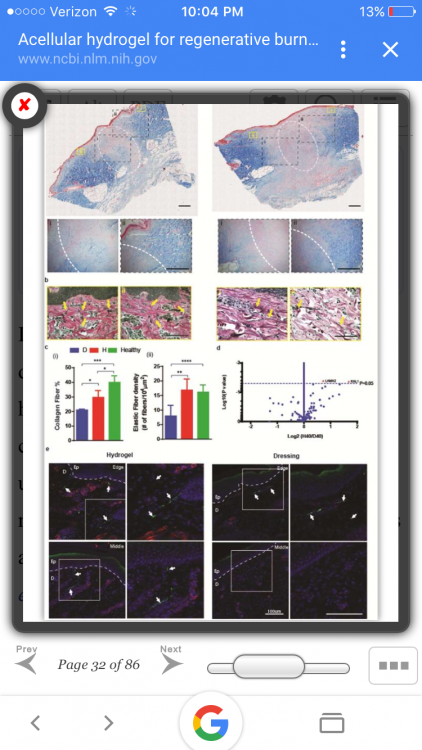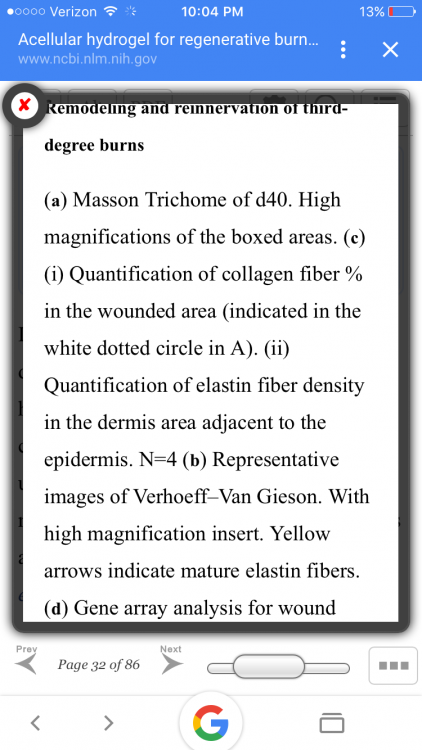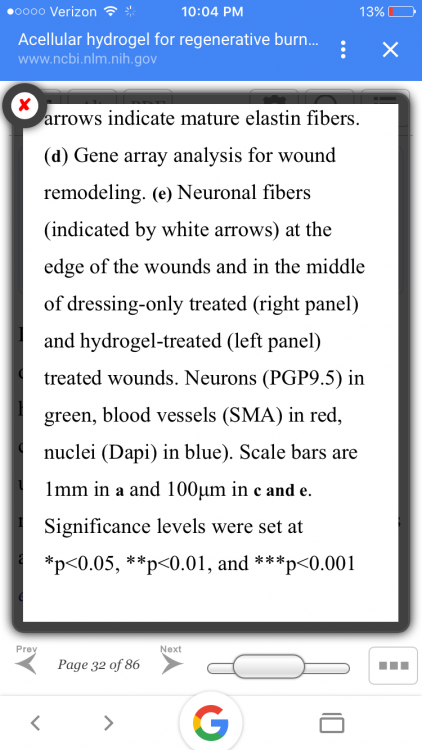Reading the materials and methods from Guoming Sun's study, and reading the acellular hydrogel in a porcine model as well... it looks like neither of these hydrogels will work without major adjustments. The highest level of dermal differentiation is rated as a 4, even though this marker INCLUDES "superficial fibrosis." So unless I'm mistaken, even the highest ranking includes scarring, and the dextran hydrogel didn't even get to the 4th degree. In addition, the gemstone study (acellular hydrogel) did show what the collagen density was, and it was not the same as normal skin in a direct comparison. So unless something major changed, neither of these will be the solution we're looking for.
I keep going back and forth on if these hydrogels are "good" or "bad," when they're both. They're imperfect which blows but they do make massive improvements from what I can tell. If you have trouble reading scientific studies like I sometimes do, don't hesitate to re-read.
https://www.ncbi.nlm.nih.gov/pmc/articles/PMC4570841/#!po=36.6279
The dextran hydrogels, in a pig model, don't recreate the same amount of collagen that exists in uninjured skin. But it does create just as much elastin density, even more so than uninjured skin. This is still an improvement.
This is gemstone's hydrogel by the way, and I'm pretty sure it's the most recent literature to date. Hopefully Sunogel is better though it is also dextran.
https://www.eurekalert.org/pub_releases/2017-01/uops-uft010517.php
GUYS READ THIS. IT'S ALL OVER THE NEWS
1 hour ago, CollegeKidd said:https://www.eurekalert.org/pub_releases/2017-01/uops-uft010517.phpGUYS READ THIS. IT'S ALL OVER THE NEWS
So they're gonna solve first the androgenetic alopecia problem and then maybe prevent scarring? Lol very easy
I also have hair loss problems, and know a bit more about it than skin. George Cotsarelis has been studying hair loss and advancing the field
for a while, but tends to make over-ambitious claims when it comes to curing hair loss. He along with other researchers helped elaborate on the role of PGD2 in androgenic alopecia. He's a smart, prolific guy but we're going to need to see more about this stuff before we can say "Eureka"
An end to scars? Breakthrough could heal wounds without leaving a trace
On 12/30/2016 at 11:08 PM, scarred2468 said:I keep going back and forth on if these hydrogels are "good" or "bad," when they're both. They're imperfect which blows but they do make massive improvements from what I can tell. If you have trouble reading scientific studies like I sometimes do, don't hesitate to re-read.
https://www.ncbi.nlm.nih.gov/pmc/articles/PMC4570841/#!po=36.6279
The dextran hydrogels, in a pig model, don't recreate the same amount of collagen that exists in uninjured skin. But it does create just as much elastin density, even more so than uninjured skin. This is still an improvement.
This is gemstone's hydrogel by the way, and I'm pretty sure it's the most recent literature to date. Hopefully Sunogel is better though it is also dextran.
The density of collagen fibers was evaluated after 40 days. The deposition of new collagen during "normal healing" only begins to form after 4-6 weeks afterwards (during which there is deposition of collagen, but its usually tied to the scarring-cascade type, product of overexpression), which this gel tries to overpass), with collagen remodeling taking anywhere between 6 months to 2 years to be truly "over". Ergo, it's unrealistic to asume that somehow the collagen structure doesn't density at this mark would be nearing that of healthy skin considering that this is a process and you are actually trying to avoid the kind of excess that results in scarring. After all, the only extraordinary thing that the hydrogel is doing is accelerating the process of re-epithalization just enough to avoid the type of excessive cascade that leads to scarring. Collagen deposition and remodeling can't be overriden to magically produce intact skin, but the theory behind this is that by preventing that overexpression reaction you can modulate a more gradual process and hence nominal looking result.
The authors of of the paper actually acknowledged that 40 days it's early in the process when they say that the regeneration seen by this point features "favorable fiber frameworks for the later phase of wound healing" (i.e. remodeling). We have no idea what the excess of elastin will do -besides giving better functionality (of course)- for actual volume, but these fibers are missing in early scar tissue and most of what is present is formed de novo after months, when they can't do much to shape the properties (their presence is very good). They also made passing reference to the fact that due the morbidity of the particular injury (third degree-burn) and condition-specific complications, it's not adequate to gauge the product's efficacy in other treatment:
"It is important to note that the treatment groups utilized in our study are modeled on clinical care guidelines for third-degree burn wounds. Although the burn wound is completely excised in this model prior to hydrogel application, these wounds cannot be considered simple excisional wounds. Locally, edema develops even beyond the periphery of the excised tissue (as shown in Figure 1c). In addition, this model likely also captures the systemic hypermetabolic response which is characteristic of third-degree burn injury that includes hyper-inflammation, hormonal dysfunction and catabolism (Jeschke et al., 2007; Orgill, 2009; Williams et al., 2009), although these parameters were not specifically examined in the current study. As such, these wounds differ from simple excisional wounds for local tumor removal or acute localized trauma. Given this systemic response to burn injury and the delay in excision, comparison of these wounds to simple excisional wounds in the same individual pig is invalid."
Burns present all sorts of complications... Circulatory inefficiency, high prevalence of necrosis, etc. that as they note, are expected to hinder the process even after excision and treatment due to lingering effects. You guys only need to be concerned with regenerating "simple excisional wounds" following the excision of the scar tissue, which is not even full-thickness.
(cont.)
(...)
I suspect that this is also why Guoming Sun is making reference to generic "cutaneous wound" in relation to Sunogel instead of the more morbid and complicated third degree wounds and diabetic ulcers that Gemstone focused on their literature. Anyways, if you "only" have acne scars, you should be concerned with the hydrogel' skin efficacy's in acute wounds, which Gemstone announced that were going to be studied after this paper, a study that based on their progress report, was likely completed long ago despite not being published AFAIK.
Unfortunately, they did not publish any follow-ups and this study, along the unpublished acute wound study were likely regarded as part of the "Reproduce Results" step in their lab to market plan ( http://us11.campaign-archive1.com/?u=6f7c4db0232c355336ce40c68&id=1c3b738bc7&e=e785f2acb2), which was presumably followed by the since-completed chemical and quantitative optimizations. That this study was carried out between late 2014/early 2015 and they have since gone silent is actually a good sign, as this was a traditional "proof of concept" paper published to woo potential investors and give the university some props for employing its labs.
Whatever happened in that lab after the funding round of mid-2015 is a mystery, since they took the path that most traditional startups take and entered an hermetic silence. It likely involved the optimization processes, that last examination on residual contaminants that is marked as completed in their chart and the other in vivo studies that they criptically reference in the document. We can only guess what exactly this means for the efficacy of the product, but the general silence in 2015 implies that they were busy and maybe not entirely satisfied with the results of the paper you quoted (it screams "thinkering"). There was also a relocation offices during that year, but it's hard to know if this affected the actual research. Likewise, the increased media activity during the second half of 2016 implies that they moved past that phase, found a formulation that satisfied them and the remaining was nitpicking. However, that they intend to file a 510(k) FDA clearance request makes it clear that these tweaks do not include stem cells or any other biological or pharmacological element. The announcement that they intend to pursue hair restoration as an avenue suggests confidence in the final product, as you likely know by your familiarity with that research that several attempts at hair cloning trough other methods have failed early on and you don't enter a new market with the expectation of failure while fully immersed in other research. Implying that somewhere along the way, the recurrence of new hair follicles became so prevalent that they decided to exploit it.
In 2015 they estimated that once the request was granted, they expected to breeze trough human trials and have a product in market within a year, how that changed remains to be seen, but it is likely that the plan is to carry out the human trials consecutively. This year we should see how this pans out. In the meantime, lets try to prevent drowning in a glass of water by making premature judgements.
7 hours ago, Frasier said:So, Rick, what are your hopes for the hydrogel regarding acne scars? You surely described it well, but I´ll guess I am not smart enough to understand the scientific terms
I expect it to work better in acute wounds than full thickness and pathologically complicated third degree wounds/diabetic ulcers. If they are truly regenerating hair at a rate that makes it practical for donor zone regeneration, then my expectations are quite high for the cosmetic aspect (even if composition is not exactly the same as "normal", what you actually want is the appearance of normalcy; this is explained to people undergoing laser treatment in which the new collagen is not of the same type and takes a while to replace). Gemstone is focusing in that market because what we have to treat those wounds is trash. On the other hand, Sun has focused his scarce comments discussing the use for acute wounds, which may support my suspicions.
For acne scars, excision will be required, with more confined scars and those with defined edges being easier to treat. I have seen solid results using manual excision as it is, and this should be an impressive boost to a method that all derms master and which is less expensive than the altentative.
But, even if it doesn't fully regenerate (hard to know, since we are lacking current information on formulation/protocols and there was no follow-up to that paper) the results should be better than anything accomplished by current methods. For example, lasers can't do much for the pitting (which I figure is what bothers most acne patients), but if you can fill the gap and end up with something that looks close to normal, they can do their part to help with texture.
The same guy who's trying to use hair regeneration as a means to induce adopocyte differentiation (George Cotsarelis) also helped found a company (Follica) which is designed to create new hair follicles. Follica is in phase 2 or 3 already if I'm correct, but the treatment is not designed to correct scars. There could be some overlap though.Hopefully new legislation like the 21st cures act can turn these stem cell advancements into cures that are 3 years away instead of 8-10. We'll see. But they still need to do preclinical work before they go through the FDA
1 minute ago, scarred2468 said:The same guy who's trying to use hair regeneration as a means to induce adopocyte differentiation (George Cotsarelis) also helped found a company (Follica) which is designed to create new hair follicles. Follica is in phase 2 or 3 already if I'm correct, but the treatment is not designed to correct scars. There could be some overlap though.Hopefully new legislation like the 21st cures act can turn these stem cell advancements into cures that are 3 years away instead of 8-10. We'll see. But they still need to do preclinical work before they go through the FDA
Also I'm pretty sure FDA approval is a lot quicker when no "drugs" are being used. This seems as though it will only be using your own fat cells, which they already do in plastic surgery for certain procedures.
Question: if fat contains cells necessary for scarless healing, and this is truly the missing component, why don't fat grafts cause skin to regenerate? Are the fat cells unable to travel to the wound? What is special about these adipocytes that was unattainable through fat transfers before?
Hi all,
Has anybody (esp. people in Canada) heard about the FS2 antiscarring topical cream that is being developed by researchers at theUniversity of British Columbia (and which recently completed Phase 1 Clinical Trials.
I have watched a few of their presentations and it seems promising.
2 hours ago, HCAS said:Hi all,
Has anybody (esp. people in Canada) heard about the FS2 antiscarring topical cream that is being developed by researchers at theUniversity of British Columbia (and which recently completed Phase 1 Clinical Trials.
I have watched a few of their presentations and it seems promising.
I watched the video on this and it seems as though in humans it only "reduces scarring".
Actually I'd forgotten that FS2 has completed phase one, so they might not be so far apart.
 Acne.org Products
Acne.org Products

